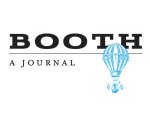Lit Mag Spotlight: Ecotone
by Treehouse Editors
Our free Literary Loot Contest for Unusual Prose,
now closed to submissions, will award a sweet prize supplied by a
collaboration of literary magazines, journals, and indie presses:
A Strange Object • Barrelhouse • Booth • Carolina Quarterly • Dzanc Books • Ecotone • Gigantic • Gulf Coast • Mud Luscious Press • PANK Magazine • REAL: Regarding Arts and Letters
Our genre-bender editor Caleb Andrew Ward interviewed Sally Johnson, managing editor of Ecotone Journal:
Q: Ecotone Journal was founded in 2005 and is in its fourteenth issue. What are some of the differences you see in the current issue from its original inception?
A: If you look at the very first issue of Ecotone and our most recent (the “Abnormal Issue”) I think the main difference is really visible in the design. For one, it’s a different trim size. Also, the general growth in aesthetics over the years is very clear. That’s due to a lot of factors: a major one being time and the advancement of not only our general aesthetic, but also the cultural or societal style and taste changes over the years. Another thing to remember is that a staff of graduate students mainly runs Ecotone. While Emily Smith (designer, poet, publisher extraordinaire) has been with Ecotone since its beginning, an MFA student designer has been a rotating under-her-wing figure. Currently it’s the wonderfully talented Ana Alvarez. Just like the shift (be it large or small) in content when a new editor takes over, so does the vision for the journal physically.
Speaking of content, I think through the years we’ve held a delicate balance in taking our theme of “reimagining place” to new places and holding it closer and farther away from us. Some issues, like this upcoming one, really hone in on place and environment. While others, like, say, the “Abnormal Issue” are less focused on that. To me, rather than indicating an unstable or unhinged goal, it shows our range and our ability to keep our purpose the same no matter how different each issue is: produce great art.
Q: The current issue is “The Abnormal Issue,” so can you share with us what the next theme is and when it will be released?
A: Ecotone is a biannual journal, published in the spring and fall. Each year, our fall issue is themed and our spring issue is not: we like to keep things interesting. Our “Abnormal Issue” was from Fall 2012. This spring we’ll be releasing our Spring 2013 issue, number 15! It isn’t themed but as we’ve been assembling it, a clear undercurrent of “home” has been very present: what home is, where it is, do we have just one? As a journal, Ecotone embraces the subversion just as much as the embrace of a theme or idea, so if we find a piece that turns an idea on its head and one that attacks it head-on, we’re happy.
Our next themed issue will come out this fall and is the “Migration Issue.”
A fitting theme considering our new editor will be in transition then: both from their home to Wilmington and from their previous gig to being EIC of Ecotone.
Q: On the topic of Ecotone’s latest issue, what have the editors considered as “abnormal” fiction, nonfiction, poetry, etc?
A: Well, at the time we announced it we had a general sense of “let’s get a lot of great, weird stuff” but mostly we were pretty excited to see what would roll in. Putting a theme on an issue each year we run the risk of limiting writers, something we’d hate to do. Keeping that risk in mind, we usually like to do themes that can focus in on an issue but explode and expand on the page. We kept thinking of all the different ways an essayist or poet or short story writer could have run with the idea of being “not normal.” Maybe it’s in the form or expectation like the selections we featured from Marvin Bell and Christopher Merrill’s collaboration Everything at Once. Or perhaps it’s just a strange concept or plot, more like Andrew Tonkovich’s Falling in which an enormous hole opens up in a religious commune, gobbling a man whole. Then there’s Jen Percy’s essay, Wildman in which she visits Kennesaw, Georgia, and enters a neighborhood store stocked with sinister relics of the South and meets the reincarnation of Stonewall Jackson. We were thrilled at the variety of submissions and truly in love with how abnormal everything turned out to be without having to compromise Ecotone’s standard for literary excellence.
Q: When did you first join Ecotone, and have you noticed a decline in purchases due to E-readers since you began as the Managing Editor?
A: I’ve only been Managing Editor for Ecotone since August of 2012, but I’ve been involved in the class as a reader since August of 2011. Since I joined? No, not particularly. However, there is a definite shift in other ways due to advancing technology and thus decreasing dependence on the printed form. For instance, our library subscription has dropped, but our subscriptions through Project Muse have skyrocketed. As readers, we’re becoming more and more willing to forgo the physical, I think. That’s terrible news for us, technically, but as Ecotone has always been about finding opportunity in risk, we know that with the changing of how people read or who reads there’s a chance to stake out new territory. This year we’re planning on launching a blog and totally redesigning our website. Bottom line: we want to reach out to our readers, wherever they are and however they are reading. While we’ll always do that through our beautiful, meticulously-made printed journals, if there’s a chance to find more Ecotone fans behind a screen, we’ll be there, too.
Q: What is your job as the Managing Editor?
A: I think the best way to answer that question is by saying I don’t have a single job as Managing Editor but a lot of jobs. I also can’t exactly give you an “average” day in the life since it depends on the time of year, where we are in the production schedule, if a grant is due, etc. But, my biggest job as I see it is making sure Ecotone gets printed on time and is the best magazine it possibly can be.
I’m in charge of things like making sure the galleys get to authors, getting authors their contracts (and getting them paid!), making sure we have the final version of a piece before it goes in for threading. Also, since Ecotone is run as a class, it’s my job to make sure the class is learning as well as corresponding with genre editors and students about what’s on deck for the next week. There’s also a lot of boring stuff like getting the mail, answering emails, writing grants, and things of that nature. I also man Ecotone social media. A ton of what I do is correspondence, making sure everyone is on the same page and connecting the dots. But, with the genre editors behind me: Carson Vaughan (NF), Nicola DeRobertis-Theye (F) and Regina DiPerna (P)? It’s easy and fun.
Q: Who are some of the bigger names that Ecotone has had the privilege of publishing in the past?
A: Ecotone has been home to so many talented and fantastic writers. As far as name-recognition goes we have a pretty impressive list that includes Ron Rash, David Shields, Billy Collins, Mark Doty, Philip Levine, Rick Bass, Ben Fountain, Mary Ruefle, Joy Williams and Ander Monson. I could go on and on. Obviously, all of these folk are mega-talented, hence the name recognition. But, I think it’s important to recognize writers who aren’t yet “big” since everything we publish in Ecotone is outstanding work that we fell in love with. When we publish an author’s first publication it’s so exciting, and I’m usually always thinking, big name or not (yet), “I can’t believe we got this piece. I can’t believe we get to show it to people.” That’s a great feeling.
Q: In the past eight years since Ecotone’s start it has been nominated for numerous awards and has had some of its more recent work re-published in Best American Essays, Best American Short Stories, and Best American Poetry. What is up Ecotone’s sleeve for the future?
A: Whenever we get news about those nominations and awards we’re just thrilled because that means someone (or a lot of someones) was just as head-over-heels about a piece as we were, and it usually means more people will get to read it, and that’s the whole point. The plan for future issues is to keep trying to out-do ourselves, keep pushing ourselves more, especially with our new website. Hopefully that means more awards!
Q: What kind of work does Ecotone do in accordance with Lookout Books (another publication from UNCW)?
A: Lookout Books is our sister imprint. It’s a teaching press at UNCW head up by the truly and fantastically talented Emily Louise Smith. Lookout Books (and there are four of them now!) are all written by an author who was first an Ecotone contributor. Since Lookout is a teaching press it is run, in large part, by graduate students who take a practicum and work in the Publishing Laboratory on UNCW’s campus. What’s most exciting about this partnership we have with them is watching an author we first loved in our pages get the spotlight they deserve for a whole book. Our relationships with those authors are invaluable and unique.
Q: If you could make any bug talk which one would it be and why?
A: Oh, tough question. But, maybe I’ll give a corny poet answer and say: I wouldn’t need to make any bug speak; they do a ton of communicating as it is. I think the reason I like researching arthropods so much (I’m writing a collection of poems that involve bugs and their sex lives) is because they lead very interesting existences, evolutionarily and physically, and that means I can put a whole ton of metaphor on top of them and they hold that weight really beautifully. Though, maybe I’d just ask a house spider to give a PSA about how not okay it is to kill house spiders. You’re just worsening your bug problem, right there.

